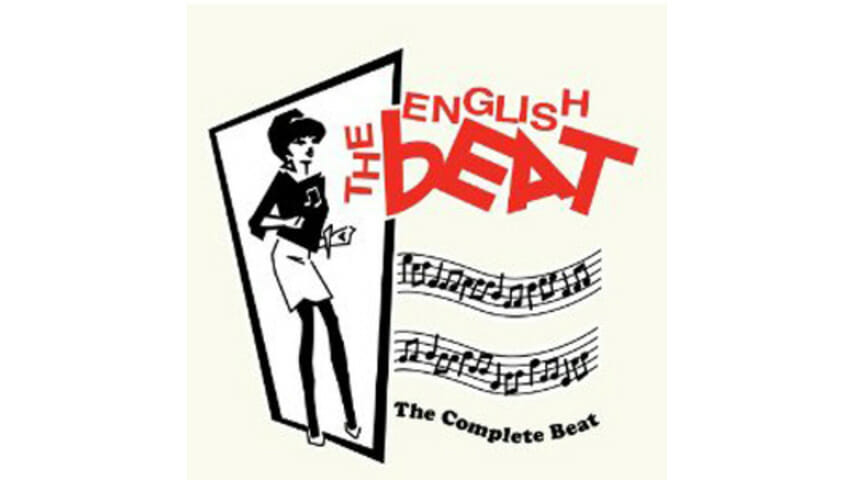
Ska gets a bad name in the States, thanks to a million skatastrophic puns, a fanbase that seemingly subsists on hackeysack and Bob Marley posters, and crappy bands like the Mighty Mighty Bosstones and 311. In Britain, however, ska has a much different musical connotation—as well as a very different sartorial sensibility. During the 1960s and 1970s, a large Caribbean immigrant population passed the double-time tempos and energetic rhythms up from the underground into the mainstream. Multiracial groups like The Specials, Madness, and the English Beat stormed the charts in the early 1980s, mixing pub rock with ‘60s dancehall rhythms and toasts. Think Desmond Dekker rather than rocksteady stars like Johnny Nash and Bob Marley. If the primary function of ska is to get people moving, then the drummer sets the pace, the guitar crackles in staccato lines, and the bass adds countermelodies that can twist a dancing body into contorted shapes.
Of the UK ska bands who found fame in the ‘80s, the English Beat were arguably the best and certainly the most ambitious, not only reinventing old soul hits (including Smokey Robinson’s “Tears of a Clown”) but also mixing various styles into their ska pop: American R&B, Afropop, even what sound like Creole instruments. They weren’t as militaristic as The Specials, who played up the gangster aspect of ska, but the English Beat wrote more pointed lyrics, occasionally brilliant (“Mirror in the Bathroom”) and occasionally flat-footed (“Big Shot”). They remain a cult act in the U.S., famous primarily for “Mirror in the Bathroom,” but during their short life—just three albums in five years—the Beat released one classic album, one really good one and one fair. They played long, raucous, sweaty live shows, but toured mostly in Europe rather than the U.S.
Shout! Factory has gathered those three studio albums, along with two discs of rarities and live cuts, into the exhaustive box set The Complete Beat, which is so good that even listeners who swear they don’t like reggae will find much to love. They might actually be better served to pick up Best of the Beat, a 1xCD hits collection that, while obviously not as exhaustive as the box set, offers a pretty persuasive introduction to the group. (The label is also releasing a live CD/DVD in the fall, Live at the US Festival 82 and 83.) The English Beat—or the Beat, as they were known in their home country—formed in Birmingham in the late 1970s, a multiracial act sprouting from the city’s modest pub rock scene. The back-to-basics, proto-punk aesthetic of that movement gave the band its sense of urgency, which meant faster tempos. The addition of Ranking Roger and saxophone player Lionel Augustus Martin (a.k.a. Saxa), not to mention the agile rhythms of drummer Everett Morton, allowed them to assay complex rhythms into short, sharp pop songs.
Funny story: During their earliest shows, they had trouble convincing fans that they were playing dance music. According to the new liner notes, it wasn’t until they unveiled their logo—an old-school rendering of a young woman executing a dance move—that crowds started moving around at their shows. That anecdote must speak more to the sensibilities of late-’70s concertgoers in England than it does to the music itself. It’s hard to imagine anyone not moving a body to their 1980 debut, I Just Can’t Stop It. More than the intricate rhythms, the catchy shout-along choruses, or the slyly melodic sax interludes, what really makes the album so memorable is the tempo, which rarely flags from one song to the next. True to its title, it just can’t stop; the English Beat throw out one undeniable jam after another. Even when the lyrics veer toward the killjoy, as on “Big Shot” and “Click Click,” the music percolates so manically that you don’t quite buy their intimations of mental illness and suicide. But the busybody mix of sounds and styles only makes their cries of “love and unity” on “Whine & Grine/Stand Down Margaret” all the more resonant. Musically, they’re putting those principles into practice.
I Just Can’t Stop It proved a jumping-off point for their next two albums, although neither managed to achieve that same sense of urgency or inventiveness. Although not for lack of trying: If their debut announced a band that had quickly developed a strong and original sound, Wha’ppen? in 1981 tweaked it considerably. The English Beat slowed the tempos way down to emphasize a greater range of island sounds: the calypso flavor of “French Toast,” the angular aggression of “Drowning.” They would continue these experiments on 1982’s Special Beat Service, when a new line-up would put a little more fire in these musical adventures. The results—especially the single “I Confess,” with its eloquent piano line—can be galvanizing, but never quite as danceable or as undeniable as their debut. These two albums reveal a band stretching to meet their ambitions and making a conscious effort to avoid the rut of repetition. They’re fine, spirited albums, more than occasionally enthralling, but both have the distinct disadvantage of following one of the great debuts of the era.
The 2xCD Bonus Beat expands on the trio of studio albums, offering extended and dub versions of most of their hits as well as three Peel Sessions and four live cuts. It’s the latter that’s most compelling, if only because it takes them out of the relatively hermetic environment of the studio and puts them in front of an audience. The Complete Beat argues that the band made solid albums as full statements, but this handful of tracks—especially “Tears of a Clown” and “Get-A-Job/Stand Down Margaret”—show them in their natural setting. Ultimately, it takes an audience to complete the English Beat’s music and arguably to realize its full potential. You can’t hear the fans dancing on those songs, but it’s there in the recording just the same.